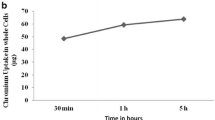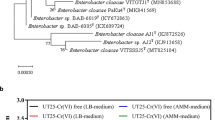Abstract
Purpose
This study had an objective to identify the most potent chromium-resistant bacteria isolated from tannery effluent and apply them for bioremediation of chromium in tannery effluents.
Methods
Two such strains (previously characterized and identified by us)—Enterobacter aerogenes (NCBI GenBank USA Accession no. GU265554) and Acinetobacter sp. PD 12 (NCBI GenBank USA Accession no. GU084179)—showed powerful chromium resistivity and bioremediation capabilities among many stains isolated from tannery waste. Parameters such as pH, concentration of hexavalent chromium or Cr (VI), and inoculum volume were varied to observe optimum bioconversion and bioaccumulation of Cr (VI) when the said strains were grown in M9 minimal salt media. E. aerogenes was used to remediate chromium from tannery effluents in a laboratory level experiment.
Results
Observation by Scanning Electron Microscope and chromium peak in Energy Dispersive X-ray Spectroscopic microanalysis revealed that E. aerogenes helped remediate a moderate amount of Cr (VI) (8–16 mg L−1) over a wide range of pH values at 35–37°C (within 26.05 h). High inoculum percentage of Acinetobacter sp. PD 12 also enabled bioremediation of 8–16 mg L−1 of Cr (VI) over a wide range of temperature (25–37°C), mainly at pH 7 (within 63.28 h). The experiment with real tannery effluent gave very encouraging results.
Conclusion
The strain E. aerogenes can be used in bioremediation of Cr (VI) since it could work in actual environmental conditions with extraordinarily high capacity.













Similar content being viewed by others
References
Arnold JW, Boothe DH, Suzuki O, Baily GW (2004) Multiple imaging techniques demonstrate the manipulation of surfaces to reduce bacterial contamination and corrosion. J Microsc (Oxf) 216:215–221
Beveridge T, McLean J, Phipps D (2000) Isolation and characterization of a chromium-reducing bacterium from chromate copper arsenate-contaminated site. Environ Microbiol 2:611–619
Camargo FAO, Bento FM, Okeke BC, Frankenberger WT (2003) Chromate reduction by chromium-resistant bacteria isolated from soils contaminated with dichromate. J Environ Qual 32:1228–1233
Dey S, Paul AK (2010) Occurrence and evaluation of chromium reducing bacteria in seepage water from chromite mine quarries of Orissa, India. J Water Resource Protect 2:380–388
Dhal B, Thatoi H, Das N, Pandey B (2010) Reduction of hexavalent chromium by Bacillus sp. isolated from chromite mine soils and characterization of reduced product. J Chem Technol Biot 85:1471–1479
Esmaeili A, Mesdaghi Nia A, Vazirinejad R (2005) Chromium removal and recovery from tannery wastewater by precipitation process. Amer J App Sci 2:1380–1490
Ganguli A, Tripathi AK (2002) Bioremediation of toxic chromium from electroplating effluent by chromate-reducing Pseudomonas aeruginosa A2Chr in two bioreactors. Appl Microbiol Biotechnol 58:416–420
He Z, Gao F, Sha T, Hu Y, He C (2009) Isolation and characterization of a Cr (VI)-reduction Ochrobactrum sp. strain CSCr-3 from chromium landfill. J Hazard Mat 163:869–873
Horitsu H, Futo S, Miyazawa Y, Ogai S, Kawai K (1987) Enzymatic reduction of Cr (VI) by Cr (VI) tolerant Pseudomonas ambigua G-1. Agric Biol Chem 51:2417–2520
Hu MZC, Norman JM, Faison BD, Reeves ME (1996) Biosorption of uranium by Pseudomonas aeruginosa strain CSU: characterization and comparison studies. Biotechnol Bioeng 51:237–247
Lee SE, Lee JU, Chon HT, Lee JS (2008) Microbiological reduction of Cr (VI) by indigenous chromium-resistant bacteria in sand column experiments. Environ Geochem Health 30:141–145
McCarty PL (1994) Groundwater treatment for chlorinated solvents. In: Matthews JE (ed) Handbook of bioremediation. Lewis Publishers, Ann Arbor, pp 87–116
Megharaj M, Avudainayagam S, Naidu R (2003) Toxicity of Cr (VI) and its reduction by bacteria isolated from soil contaminated with tannery waste. Curr Microbiol 47:51–54
Mishra S, Doble M (2008) Novel chromium tolerant microorganisms: isolation, characterization and their biosorption capacity. Ecotoxicol Environ Saf 71:874–879
Norris RD (1994) In-situ bioremediation of soils and groundwater contaminated with petroleum hydrocarbons. In: Matthews JE (ed) Handbook of bioremediation. Lewis Publishers, Ann Arbor, pp 17–37
Ramakrishna K, Phillip L (2005) Bioremediation of Cr (VI) in contaminated soils. J Hazard Mat 121:109–117
Sambrook J, Russel DW (2001) Molecular cloning: a laboratory manual. CSHL Press, New York
Sattley WM, Madigan MT (2006) Isolation, characterization, and ecology of cold-active, chemolithotrophic, sulfur-oxidizing bacteria from perennially ice-covered Lake Fryxell, Antarctica. Appl Environ Microbiol 72(8):5562–5568
Srinath T, Verma T, Ramteke PW, Garg SK (2002) Chromium (VI) biosorption and bioaccumulation by chromate resistance bacteria. Chemosphere 48:427–435
Standard Methods for the Examination of Water and Wastewater (1989) American Public Health Association, Washington DC
Sundar K, Vidya R, Mukherjee A, Chandrasekaran N (2010) High chromium tolerant bacterial strains from Palar River Basin: impact of tannery. Res J Environ Earth Sci 2:112–117
Thacker U, Madamwar D (2005) Reduction of toxic chromium and partial localization of chromium reductase activity in bacterial isolate DM1. World J Microb Biot 21:891–899
Zhiguo H, Fenglish F, Tao S, Yuehua H, He C (2009) Isolation and characterization of a Cr (VI)-reduction Ochrobactrum sp. strain CSCr-3 from chromium landfill. J Hazard Mat 163:869–873
Acknowledgments
The author JP gratefully acknowledges fellowship provided by the University Grants Commission (UGC), India. The author PS acknowledges a research fund from the UGC and support from Sensor-Hub, CGCRI for characterization and analysis.
Author information
Authors and Affiliations
Corresponding author
Additional information
Responsible editor: Philippe Garrigues
Rights and permissions
About this article
Cite this article
Panda, J., Sarkar, P. Bioremediation of chromium by novel strains Enterobacter aerogenes T2 and Acinetobacter sp. PD 12 S2. Environ Sci Pollut Res 19, 1809–1817 (2012). https://doi.org/10.1007/s11356-011-0702-2
Received:
Accepted:
Published:
Issue Date:
DOI: https://doi.org/10.1007/s11356-011-0702-2




